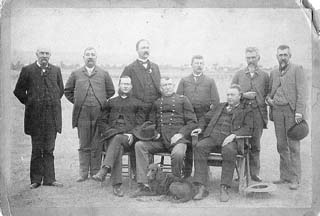
Dick Miller returned to Rochester excited to attend his high school reunion and anxious to spend some time at the Fairfield Cemetery. Most people do not talk about cemeteries with the enthusiasm Miller does, and maybe that is because they don't know the stories he knows. Last week, Miller, along with his wife, Susan, used a trip to Rochester to spend a couple days in Spencerport conducting some research on a former Spencerport resident. In January of this year the 57-year-old Miller, who now lives in Massachusetts after growing up in Gates, stopped working as a marketing consultant to dedicate himself to researching his deceased great, great uncle Libbeus Foster Spencer, the son of Spencerport's founding father Daniel Spencer. Admittedly, Miller has never done anything like this before. His wife Susan, while supportive, said she was shocked by his newfound passion. "It really has been a great experience for our family," she said. "But when he told me what he planned to do I said, 'That's nice, and what do you plan to use for money?' " Miller's introduction to his historically significant, if not famous, great relative came about 40 years ago, when he came across some photos of Spencer. They were in a collection his grandfather had, which Miller figures must have been passed down by his great grandmother who moved into Spencer's Spencerport home at 127 West Avenue. After decades of holding the photos, Miller used a slow economy as a good excuse to break away from his normal routine to begin researching Spencer. Miller has been working seven days a week, 10-hour days uncovering the life and times of his uncle for nearly seven months. His research has taken him to The Smithsonian; the National Archives; the Bureau of Indian Affairs; the Carlisle Indian School; the Rosebud Reservation, including Sinte Gleska University and the Sicangu Heritage Center; research libraries at Yale and the University of Chicago; state historical societies and museums in Colorado, Nebraska, South Dakota and Minnesota, and Stockholm, Sweden. While spending two days in Spencerport recently, Miller and his wife met with librarians, historians and a cemetery curator. Miller's plan was to shake the bushes trying to find anyone who knew anything about his uncle. They even hung up wanted posters asking locals to call with any information. Miller said visiting the Fairfield Cemetery was helpful in verifying and correcting date information. Actually seeing 127 West Avenue and comparing it to photos from the 1800s for identification was also useful. Miller said the contacts he made while in Spencerport proved to be invaluable to his work. His hope, however, is that the best is yet to come. "I expect that the great part of information on Spencer and Native Americans is yet to come out of the archives, but that will be the formal reports, letters, inspections, and the such," said Miller. "Many answers to my questions are buried with my uncle and his family in Fairfield Cemetery," said Miller. "My hope is that people who live in Spencerport might be able to come forward with evidence of his life and service which may lie buried in dark corners of basements, attics or drawers in the village." From what Miller has been able to piece together, he has ascertained that L.F. Spencer was appointed in 1885 by President Grover Cleveland to be Indian Agent on the Sioux Rosebud Reservation in Dakota Territory. Photos Miller was able to obtain indicate that L.F. Spencer was in the middle of the action surrounding the Indian Wars of the late 1800s. He served at Rosebud during a time when the other Sioux reservations were gaining notoriety from Indian attacks, full-scale wars, problems with Sitting Bull, and religious events leading up to the massacre at Wounded Knee in 1890. He served with the 1888 Sioux Commission led by Capt. Richard Pratt, who founded the Carlisle Indian School in Carlisle, Pennsylvania. He stood side-by-side with Major James McLaughlin, the Indian Agent at Standing Rock Reservation who ordered the arrest of Sitting Bull, which led to his death. He accompanied a large delegation of Sioux Chiefs to Washington D.C. in October 1888 to meet President Cleveland. Spencer was born in Spencerport in 1833 and died in Spencerport in 1904. He is buried in the Fairfield Cemetery. He was a charter member of the Etolian Lodge 479 F&AM, chartered June 9, 1860, and was supervisor of the town of Ogden, 1878-80. In census records, he is identified as a coal yard operator. Despite being an active participant in a well-documented historical time, Spencer appears to have been overshadowed by events and other personalities and little has been written about him or his accomplishments. Miller hopes to be able to produce an account of his uncle's life and times. His goal is to publish four books related to his work: a picture book, a biography, a historical fiction book and a book that outlines the process for writing and researching similar texts. "Since Spencer hasn't been written about extensively, I hope to dig up new historical facts from archival research and shed some light on his contributions or influence on the great American move westward," said Miller. "Through my research I have become an Indian sympathizer as I realize the atrocities that took place. I really hope that maybe my uncle contributed something positive." Those who have any information regarding the life of L.F. Spencer are encouraged to contact Miller at 978-689-8848.
|

